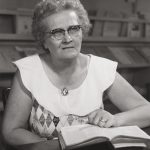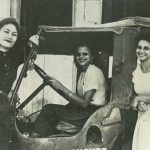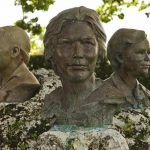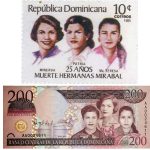buzzsprout episode=’1493812′ player=’true’]
Cecilia Payne
- Photo: Smithsonian Institution Cecilia Payne-Gaposchkin at Harvard
- Painting of astronomer Cecilia Payne-Gaposchkin by Patricia Watwood, © President and Fellows of Harvard College; Photo by Katya Kallsen
- CECILIA PAYNE-GAPOSCHKIN, RADCLIFFE PHD 1925, FIRST WOMAN TENURED FROM WITHIN HARVARD Schlesinger Library
Born: May 10, 1900 Died: December 7, 1979
Legacy: Astronomer and Astrophysicist
- Born in Wendover, England to Mother Emma Leonora Helena and father Edward John Payne.
- Her father died when Cecilia was only 4, and her mother took on raising the family on her own.
- Cecilia went to St. Paul’s Girls’ school and in 1919 won a scholarship to Newnham College, Cambridge University, where she studied botany, physics and chemistry.
- Her world was changed (her words) when she attended a lecture by Arthur Eddington on his 1919 expedition to the island of Principe in the Gulf of Guinea. The expedition was to photograph the stars near a solar eclipse to test Einstein’s theory of relativity.
- She said of the lecture: ‘The result was a complete transformation of my world picture. […] My world had been so shaken that I experienced something very like a nervous breakdown.’
- She completed he studies but was not awarded a degree because of her gender; Cambridge did not grant degrees to women until 1948.
- Cecilia realized that her only career option in the U.K. was to become a teacher, so she looked for grants that would enable her to move to the United States.
- After being introduced to Harlow Shapley, the Director of the Harvard College Observatory, where he had just established a graduate program in astronomy, she left England in 1923.
- Harlow persuaded Cecelia to write a doctoral dissertation, and so in 1925 she became the first person to earn a PhD in astronomy from Radcliffe College (now part of Harvard).
- Her thesis was “Stellar Atmospheres; a Contribution to the Observational Study of High Temperature in the Reversing Layers of Stars”.
- Payne’s thesis, finished on January 1, 1925, confirmed the view of Russell and Rowland on the abundance of the heavier elements in stellar atmospheres.
- She then applied Saha’s equations to the Balmer series absorption in hydrogen, which originates from atoms in the first excited state.
- She was the first to appreciate that, in the atmosphere of the Sun at 5700 K, only about one in 200 million of the hydrogen atoms is in this excited state, so that the total quantity of hydrogen is grossly underrepresented by the Balmer absorption.
- A similar argument holds for helium. She found similar results for other stars.
- Cecelia concluded that, unlike on Earth, hydrogen and helium are the dominant elements of the Sun and stars.
- Henry Norris Russell strongly opposed this conclusion and convinced her to omit it from her thesis.
- However, currently accepted values for the mass fraction of elements in the Milky Way Galaxy are: ~74% hydrogen, 24% helium; all the remaining elements, 2%, confirming Cecilia’s result.
- Her discovery of the true cosmic abundance of the elements profoundly changed what we know about the universe.
- Cecelia consequently described her results as “spurious”.
- A few years later, astronomer Otto Struve described her work as “the most brilliant PhD thesis ever written in astronomy”.
- Russell also realized she was correct when he derived the same results by different means. In 1929, he published his findings in a paper that admiringly acknowledged Payne’s earlier work and discovery; nevertheless, he is often credited for the conclusions she reached.
- After her doctorate, Cecelia remained at Harvard as a technical assistant to Harlow.
- Harlow had her discontinue her work with stellar spectra and encouraged her instead to work on photometry of stars by using photographic plates, even though more accurate brightness measurements could be made by using recently introduced photoelectric instruments.
- Payne later wrote, “I wasted much time on this account. My change in field made the end of the decade a sad one.”
- During this period, however Payne studied stars of high luminosity in order to understand the structure of the Milky Way. Later she surveyed all stars brighter than the tenth magnitude.
- She then studied variable stars, making over 1,250,000 observations with her assistants. This work later was extended to the Magellanic Clouds, adding a further 2,000,000 observations of variable stars.
- This data was used to determine the paths of stellar evolution. She published her conclusions in her book, Stars of High Luminosity (1930). Her observations and analysis of variable stars, laid the basis for all subsequent work on such objects.
- In 1931, Cecelia became an American citizen.
- On a tour through Europe in 1933, she met Russian-born astrophysicist Sergei I. Gaposchkin in Germany. She helped him get a visa to the United States, and they married in March 1934, settling in the historic town of Lexington, Massachusetts, a short commute from Harvard.
- Cecelia remained scientifically active throughout her life, spending her entire academic career at Harvard.
- When she began, women were barred from becoming professors at Harvard, so she spent years doing less prestigious, low-paid research jobs.
- Nevertheless, her work resulted in several published books beyond her first book, including Variable Stars (1938) and Variable Stars and Galactic Structure (1954).
- Harlow had made efforts to improve her position, and in 1938 she was given the title of “Astronomer”.
- She was elected a Fellow of the American Academy of Arts and Sciences in 1943.Her courses were not recorded in the Harvard University catalogue until 1945.
- When Donald Menzel became Director of the Harvard College Observatory in 1954, he tried to improve her appointment, and in 1956 she became the first woman to be promoted to full professor from within the faculty at Harvard’s Faculty of Arts and Sciences.
- Later, with her appointment to the Chair of the Department of Astronomy, she also became the first woman to head a department at Harvard.
- Cecelia retired from active teaching in 1966 and was subsequently appointed Emeritus Professor of Harvard.
- She continued her research as a member of staff at the Smithsonian Astrophysical Observatory, as well as editing the journals and books published by Harvard Observatory for twenty years.
- She died at her home in Cambridge, Massachusetts, on December 7, 1979.
- Her obituary read, in part, “Cecilia Helena Payne-Gaposchkin, a pioneering astrophysicist and probably the most eminent woman astronomer of all time, died in Cambridge, Massachusetts, on December 7, 1979. In the 1920s she derived the cosmic abundance of the elements from stellar spectra and demonstrated for the first time the chemical homogeneity of the universe”
Legacy
- Cecelia’s career marked a turning point at Harvard College Observatory.
- The trail she blazed into the largely male-dominated scientific community was an inspiration to many.
- While accepting the Henry Norris Russell Prize from the American Astronomical Society, Payne spoke of her lifelong passion for research: “The reward of the young scientist is the emotional thrill of being the first person in the history of the world to see something or understand something. Nothing can compare with that experience […] The reward of the old scientist is the sense of having seen a vague sketch grow into a masterly landscape.”
The Mirabal Sisters
- Archive photo of the Mirabal sisters in 1960. | Photo: Notas Argentina
- The Mirabal Sisters | Courtesy of aam.govst.edu
- Busts of the Mirabal sisters at the museum in the village of Salcedo, 150 km north of Santo Domingo on June 10, 2008. The Mirabal sisters were assasinated in 1960 during the dictatorial regime of Leonidas Trujillo. AFP PHOTO/Ricardo HERNANDEZ (Photo credit should read RICARDO HERNANDEZ/AFP/Getty Images)
- Domincan currency and stamp featuring Las Mariposas | Courtesy of latina.com
Name: Patria Mercedes Mirabal Reyes Known As: Patria
Born: 27 February 1924 Died: 25 November 1960
Patria was the eldest sister, born on February 27th, 1924. Patria was sent to a Catholic boarding school, Imaculada Conceptión in La Vega from age 14-17. When she was 17, she married farmer, Pedro Gonzalez.
Name: Bélgica Adela Mirabal Reyes Known As: Dedé
Born: 1 March 1925 Died:1 February 2014
Belgica, commonly known as Dedé (DEH-DEH), was the second oldest sister, born on March 1st, 1925. When Dede was young, her father made a prediction that, “she will bury us all in silk and pearls.” Shout out to creepy parental predictions. She was also the only sister not to go to Catholic Boarding School. She instead stayed home to take care of the homestead. Dede married her cousin Jaimito and had three children together.
Name: María Argentina Minerva Mirabal Reyes Known As: Minerva
Born: 12 March 1926 Died: 25 November 1960
Minerva was born on March 12th, 1926. She joined her sister Patria at Imaculada Concepcion at 12 years old. Upon graduating, she went to the University of Santo Domingo to study law. There, she met her husband Manolo Tavarez Justo.
Name: Antonia María Teresa Mirabal Reyes Known As: María Teresa
Born: 15 October 1935 Died: 25 November 1960
Known as Maria Teresa, the youngest daughter was born on October 15th, 1935. She also attended the same Catholic boarding school as her two sisters and later studied mathematics at the University of Santo Domingo. After graduating, she married Leandro Guzman. She greatly admired her older sister, Minerva.
The Story:
- It was unusual for Patria, Minerva, and Maria Teresa to receive educations as it wasn’t affordable for women at the time.
- Now, while the Mirabal sisters were growing up and generally killing it, things were not so great in the Dominican Republic. You see, in 1930, a certain dictator came to power. His name was Rafael Leonidas Trujillo Molina. Trujillo started out as a president for two 8-year terms. After that, he went full blown dictator, pulling the strings of a series of figurehead presidents. He controlled the news, utilities, radio, mail, the passport office and more.
- He must have also been a narcissist because he erected tons of statues of himself and named cities, parks, buildings, bridges, mountains, and more after himself. This combined with propaganda, lies, violent oppression, and other common techniques from the tyrant tool box, helped him create a cult of personality in which Trujillo appeared to be the heroic, ideal leader.
- His admirers even recommended him for the Nobel Peace Prize, which is truly horrifying when you learn that Trujillo was responsible for the Parsley massacre which was the mass murder of 20-30,000 Haitians living in the Dominican Republic.
- Naturally, the Mirabal sisters didn’t take kindly to Trujillo’s bullshit. Minerva, the sister who studied law, became involved in the political movement against Trujillo first. Though Minerva was disgusted by Trujillo’s political policies, her resistance was also personal.
- Trujillo had what he called “beauty scouts.” These were paid employees who traveled around looking for YOUNG girls for him to kidnap and rape.
- In one instance, Trujillo forced the Mirabal sisters to come to one of his parties. There, he made a move on Minerva and when he didn’t take no for an answer, she slapped him and the sisters ran the fuck out of there.
- That was not the end, though. Trujillo made Minerva’s life hell. First, her father was imprisoned and abused. He was eventually released, but died soon after. Then, when Minerva and her mother visited the capital, they were kept as prisoners in their hotel, only to be released if Minerva let Trujillo rape her. Luckily they were able to escape.
- She was banned from attending classes until she spoke positively about Trujillo and then, when she did graduate with her law degree, the government refused to grant her a license to practice law.
- Trujillo’s attacks turned the whole family into activists. Maria Teresa soon followed in Minerva’s footsteps. Patria then joined the movement after witnessing Trujillo’s men massacre a bunch of people. Dede did not join the movement, though she didn’t support Trujillo’s regime.
- Together, the three sisters formed the Movement of the Fourteenth of June, a resistance group named for the date of the massacre Patria witnessed. Shout out to the dudes, their husbands joined the resistance as well!
- They started by distributing pamphlets that exposed Trujillo’s murders and gathered bomb-making materials and weapons before openly revolting.
- The Mirabal sisters would gather around Minerva’s kitchen table to plan and assemble makeshift bombs. Knowing they were being monitored and nowhere was safe, they had codenames.
- The three sisters were collectively known as Las Mariposas or the butterflies.
- Together, they planned to assassinate Trujillo. In 1960, Trujillo was going to attend a cattle fair and would be exposed. Unfortunately, their plan was discovered and they were arrested with their husbands.
- Now, at this time, the world was beginning to take notice (or no longer ignore) Trujillo’s crimes against humanity. An assassination attempt against the Venezuelan president also had something to do with it.
- The added international pressure meant that the Mirabal, along with a lot of other female-prisoners were released. However, their husbands were not.
- Things were heating up for Trujillo. His country hated him. The world hated him. And he couldn’t stand that three women who rejected him sexually and opposed his power were gaining popularity. So he decided to solve his problems the only way a controlling, sociopathic rapist knows how.
- Trujillo transferred Minerva, Patria, and Maria Teresa’s husbands to a remote jail across a mountain range. It was an obvious trap but the sisters didn’t care.
- On November, 25th, 1960, The Mirabal sisters, along with their driver, drove their jeep to visit their husbands. After the visit, they were ambushed in the mountains by Trujillo’s men.
- Patria, knew what was happening and broke away and ran to a nearby truck. She told the driver that they were the Mirabal sisters and they were about to be murdered. The driver quickly drove away to spread the word.
- As far as assassinations go, this was brutal and messy. The men separated Minerva, Patria, Maria Teresa and their driver Rufino de la Cruz, and dragged them into a nearby sugarcane field.
- Each was strangled and clubbed to death. Patria was 36. Minerva was 34. Maria Teresa was 24.
- Their jeep was then pushed off the side of the mountain to make it look like a car accident, but everyone knew the truth.
- Minerva, Patria, and Maria Teresa’s murders had an effect on the Dominican people that Trujillo couldn’t have anticipated. According to historian Bernard Diederich, it “did something to their machismo.”
- Six months later, on May 30th, 1961, Trujillo was ambushed in his car and shot.
- The Trujillo family would later lose complete control after the Rebellion of the Pilots on November 19th, 1961.
- The details of the Mirabal sisters’ fates didn’t come out until 1996. By 1997, Dominican history books told the story of the Mirabals and depicted them as martyrs for their country.
Legacy
- The Mirabal sisters and their fight against tyranny has been recognized in many ways. There are monuments, works of art, and memorials. But one of the most heartfelt memorials to the three women was created by their sister Dede, who was predicted to bury her family.
- Dede turned their old home, in Conuco was turned into a museum called La Casa Museo Hermanas Mirabal (The Mirabal Sisters House Museum.)
- On November 25th, 2000 on the 40th anniversary of their assassination, Minerva, Patria, Maria Teresa’s remains were moved from the family vault to a grave site at the museum. They are buried there with Minerva’s husband Manolo. Dede was later buried in the family fault.
- The damaged frame of their jeep from that fateful night is also on display in a small park called Plazoleta Hermanas Mirabal.
- Salcedo Province, where they grew up, was renamed Hermanas Mirabal Province.
- FOR OUR HERSTORY STAMP COLLECTORS, the sisters have a stamp! They are alos featured on the 200 Dominican pesos bill.
- On December 17th, 1999, the United Nations General Assembly designated November 25, the day the sisters were killed, as the International Day for the Elimination of Violence against Women in their honor. The date marks a 16-day period of activism against gender violence, ending on December 10th, International Human Rights Day.







